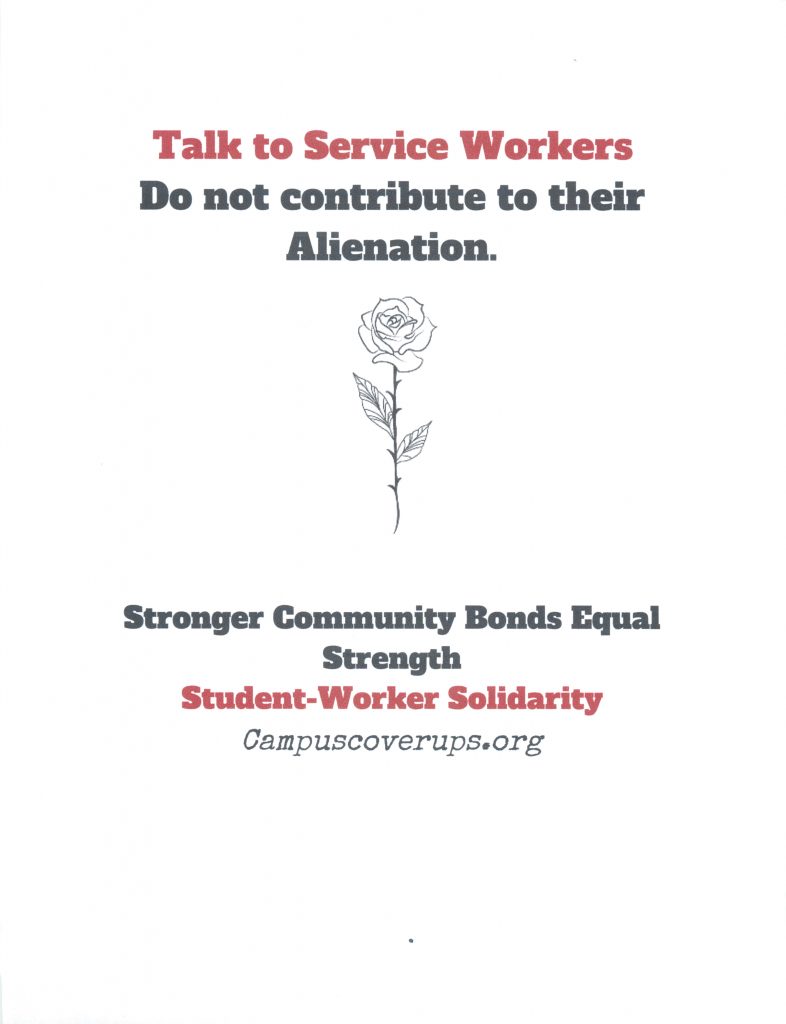Over age 70, each with over 35 years at AU



A devoted cadre cleans AU and feeds its students, faculty and staff. But these employees do not have the same benefits as others who work on campus. As an educational institution AU could offer a benefit proven effective in promoting diversity and inclusion for the university and career enhancement for the employees: free tuition for AU courses for these “outsourced” employees the same as for those faculty and staff directly employed by AU.
Service workers have also suffered from a lack of retirement benefits at AU.Many of the outsourced employees would like to retire from their physically demanding labor. But for many years they, unlike AU’s directly employed workers, had no pension benefit payment set aside for them – in some case for as much as 19 years from 1981 to 2001. As a result there’s little – very little – money in their pension fund on which to retire. And of course, Social Security benefits are minimal since much of their work was at close to minimum wage. AU should chip in to help, for example, Leila Williams– who has worked here for 51 years.
Professor Mary Gray
Department of Math and Statistics
College of Arts and Sciences
Office: 202-885-3171

Some of the Workers Who Can’t Retire
Is American University a Moral Failure?
How to Solve the Retirement Crisis with No Cost to Students
Actions at Other Schools: The Franklin and Marshall Model
American University Students and Service Workers
The Great Cover Up, Part I: AU’s Board of Trustees Lost $91 Million to a Bank and Didn’t Tell Anyone
A Survey of Educational Benefits at Universities in the District of Columbia



Currently working as a food server in the Terrace Dining Room, Leila Williams is now 80. She has prepared or served food to students at AU for over 53 years. She says she can’t afford to retire.
Ask your professors to discuss the issues in the post about the moral failure of American University. For years the people suffering the most from AU’s labor practices have been African-American and Latino. This is racism. This is classism. These policies are not acceptable.
What do faculty suggest? Please ask them before class, during class, and after class. How does AU become a community of inclusion? What pressures will persuade AU to include rather than exclude Black and Latino service workers. When will the service workers receive 10% monthly retirement contribution administrators and faculty receive rather than the 6% food service workers receive now? And when will service workers receive the same free tuition for classes that administrators and faculty receive now?
AU administrators now charge food service workers who are only paid for nine months a year, the same monthly parking charge as $500,000 a year vice-presidents. See what the Eagle had to say about this. But the Eagle spoke up too much. And so the University closed the weekly print edition of the Eagle. They said it cost too much. That $10,000 a year to print it was too much in a non-profit with a $600,000,000 annual budget.
How to Solve the Retirement Crisis at AU with No Cost to Students.
Watch a video about the no cost solution produced by an SOC graduate.
What would it cost to remedy this situation of sixteen over
65-year old workers who can’t retire?
The problem began in the 1980s when AU outsourced or privatized its food service and cleaning services to vendors. AU ignored the policies of these vendors, pretending that AU had no moral responsibility for their actions on campus. Marriott, the first food service vendor made no payments to the pensions of food service workers while it was on campus. There have been a succession of vendors since Marriott.
Please remember in addition to the empty years, approximately 1982-2001, with no retirement contributions, these workers also will receive small social security checks based on many years at or near the minimum wage. The union has identified 16 workers who need help in order to retire.
How much monthly income does a worker needs for a decent retirement?
1. Professor Mary Gray of the Math/Stats Department has suggested using twice the poverty guideline amount for an individual. The national poverty guideline amount excluding Alaska and Hawaii is $11,880. Twice this amount is $23,760.
How much income can a low income worker depend upon from Social Security?
2. A food service worker with 39 years on campus said she expects to receive about $900 a month. Medicare will deduct $121.80 for the Part B premium, leaving a net Social Security benefit of $778 a month, or an annual Social Security benefit of $9338.
What is the gap between twice the poverty guideline and what a low-wage AU worker can expect from Social Security?
3. $23,760-$9,338=$14,422 a year or $1,202 a month.
What would the monthly cost be to American University of supplementing 15 workers over 65 with over 35 years of work at AU each?
4. $1,202*15 workers=$18,030 a month
What is this amount as a percentage of AU’s monthly spending?
With a total FY2017 annual budget of $610,000,000, the University spends $50,833,333 a month. The emergency supplement of $18,030 a month would amount to (0.000355) less than four thousandths of one percent of the monthly budget. (This amount is now out of date. With the University’s new budget of over $800,000,000 a year, the amount for all the elderly workers would be less than three thousandths of one percent of the University’s monthly budget.)
Where could American University find this sum without influencing tuition?
We recommend a 10% reduction in the salaries of University Vice-Presidents or a 4% reduction in the salaries of the twelve highest paid officers of the University to fund this pension supplement. See the IRS 990 form online for the salaries of these officers. Either reduction would entirely fund the pension supplements.
In one gamble that failed in 2008, the Board of Trustees of American University lost an amount equal to about a quarter of the American University’s endowment at the time.
Did they inform the students? No. Did they tell the faculty? No. Did they tell the tuition paying and loan borrowing parents? No. AU lost $91 million in a bet on interest rates and still faces additional losses of $76 million according to a report from the Roosevelt Institute and AU’s financial documents. The bet is technically a credit swap agreement with a bank, or a bet on the direction of interest rates. AU bet interest rates would rise; rates have stayed low for years. As the Roosevelt Institute report below shows, AU was at the mercy of the bankers on its own Board of Trustees:
“American is also a good example of the powerful role that bankers often play at colleges and universities. Several members of the finance industry sit on American’s board, including high-level people at Goldman Sachs and
JPMorgan Chase. Some of these same financial companies are involved in American’s swap deals, as bond underwriters and/or swap counterparties.
For example, a high-level executive at Bank of America sat on the
board during the period that American entered into its two toxic swaps with Bank of America.” (see page 18 and page 23.)
Did University administrators talk about new financial safeguards in an email to students, parents and faculty? No. Did they institute new financial safeguards so a similar loss would never happen again? No. Or did administrators cover it up? Yes.
Please download the report at this link:
Financialization-of-Higher-Education
We appreciate the permission of the Roosevelt Institute to share this report with the community at American University rather than the normal method of purchasing the report through Sribd at the Roosevelt Institute web site.
Please join our mailing list to learn about demonstrations, and other events in support of the service workers and students at American University.